Trip Report – Easter, 3 –5 April 2015: Horowhenua
3.4.15 (a.m.): Forest Lakes Road
The day started out in ominous fashion with four of us being sent to an incorrect rendezvous, and the rest of us being the subject of a police call-out for trespassing at the assigned rendezvous. Quickly resolved, we were generously hosted by Barry O’Connor at his Forest Lakes Rd swampy bush remnant. A home-stay cottage overlooks the bush at the head of a gully that drains into a large swamp in the lower Waitohu Stream catchment. Barry has recently been asked by the regional council to restrict stock access to the area. No cattle are now on the property, the gully is fenced off, and the fringes of the swamp now boast a laxly sheep-grazed sward of exotic grasses and
Microlaena stipoides, with many native species, previously listed as uncommon, now emerging within the remnant.
The first call was a lone maire tawake /
Syzygium maire, amid the swampy ground on the edge of what is now a quite impenetrable understorey beneath a low canopy of titoki, tawa, pukatea and hinau with scattered kamahi around the edges. Thankfully, the recent dry meant that we could press on into the interior where, in light gaps, thrived blackberry,
Rubus fruticosus agg., bracken /
Pteridium esculentum, and
Muehlenbeckia australis. A surprise was a lone
Nestegis montana (dbh 27 cm) to add to Pat Enright’s comprehensive list. Previously listed as uncommon were
Carex maorica,
Machaerina tenax, big mingimingi and hen and chicken fern. These were now all increasing in number, because Barry has excluded cattle. Around the fringes of the forest it was not hard to find seedlings of titoki and the ferns
Asplenium hookerianum,
Blechnum chambersii,
B. discolor and
Pellaea rotundifolia, also previously recorded as uncommon.
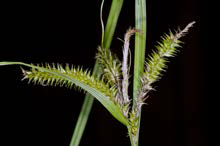 |
Carex maorica inflorescence.
Photo: Jeremy Rolfe.
|
Unfortunately barberry is now enclosing some areas and, within the swamp, seedlings and mature old man’s beard are beginning to take over. There was also the disappointment of karo,
Pittosporum crassifolium seedlings that have spread from distant hedgerows. These weeds present a real threat when stock is excluded. If the gully were to be retired from all livestock, weed control will take more effort for some years to come. Barry shared with us what a vexed issue this is. Regional council assistance with planting as to extend the bush fringe, and weed control of this unique remnant, would further enhance the already attractive cottage outlook.
3.4.15 (p.m.): Lake Waitawa
We lunched on the edge of Lake Waitawa, gathered mushrooms for dinner, then entered the nearby bush, c. 2 ha. It is overrun by human recreational activity from the nearby Christian camp. The entrance has a smattering of stinking iris. Some of the bush is dominated by large karaka.
Hoheria sexstylosa is overshadowed by plantings of the out-of-place
Hoheria populnea on the the bush fringes. In the understorey we saw the small-leaved shrubs
Melicope simplex and
Streblus heterophyllus. Larger ferns, e.g.,
Pteris tremula,
Hypolepis distans,
H. rufobarbata and
Diplazium australe are among many others typical of such disturbed areas. It also has a good canopy of totara, extensive rewarewa, the odd rimu and, in a lower area near the swamp, a large (female) kahikatea with many seedlings beneath it and, with what appeared to be roots that lifted above the water when the water level was once 2 m higher than it is now. The swampy area was dominated by wild parsnip,
Pastinaca sativa and
Carex geminata overgrown with field cornbind,
Calystegia silvatica.
We then moved to the manuka-dominated area west of the lake and botanised along its edge. There are several constructed piers with two tench and perch anglers who keenly explained the cultural origins of the pastime. Here there were swathes of
Isachne globosa / swamp millet, splendent with its fine seed heads hanging over the water. Further from shore is a tangled understorey of
Gleichenia dicarpa and much
Blechnum minus. Out into the open area, and into the open swampy area, there is a lone
Olearia virgata. Unfortunately this area was subject to heavy grazing by cattle, so the prospects of further improvement look bleak.
The day was closing so we had no time to look at further native areas surrounding the lake; most of which, from a distance, appeared to be extremely impoverished, grazed and overrun with exotic species planted around the camp’s convention centre. We thank the Forest Lakes management for access to their area.
Most native bush remnants and swamps have disappeared from the area we visited at Easter. It is wonderful to find land stewards, such as the Keelings and Barry O’Connor, who while managing a viable farming enterprise, are looking for answers to what they can do to preserve these special areas.
Mick Parsons
4.4.15 (a.m.): Kimberley Scenic Reserve
Notes on the species list described this reserve as “a patchwork of various vegetation types and ecosystems”. We explored three patches; one beside the access road, one behind the toilet block, and a short section of river bed.
The length of the species list reflected the diversity of ecosystems: five pages of indigenous plants and five pages of adventives. Maggy Wassilieff prepared the first list in the 1980s. Pat Enright and Olaf John added to it during 15 trips 2002 – 2004. Our additions included
Nestegis lanceolata,
Carex flagellifera,
Pittosporum tenuifolium (planted), and, regrettably, the weed
Selaginella kraussiana.
The highlight was
Mida salicifolia with its confusion of leaf shapes. Rhys Gardner (1997) reports that it is common north of 38°, but then almost absent until the Wellington region. The species is hemiparasitic; its roots attach to those of other plants.
4.4.15 (p.m.): Keeling’s Farm
We thank farmers Dave and Mike Keeling for allowing us access to their property. The three forest remnants here provided different botanical experiences. We started with a one-page list labelled ‘Lake Kopureherehe’, and finished the day with long lists for two remnants.
Remnant between the house and the lake
Canopy species – magnificent matai, kahikatea, tawa, northern rata, karaka and two magnolias. Lower tiers – a variety of small indigenous trees, (e.g.,
Streblus heterophyllus), shrubs, lianes and ferns.
Metrosideros fulgens was in flower. Weed infestations – many karaka seedlings, climbing asparagus. Small lakeside finds, e.g.,
Glossostigma elatinoides.
Remnant past the old shearing shed
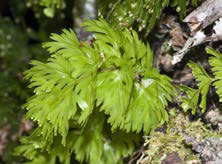 |
Hymenophyllum flabellatum.
Photo: Jeremy Rolfe.
|
In better condition botanically. The main canopy species – kahikatea. Kohekohe and nikau gave some sections a tropical appearance. Many dead
Dicksonia squarrosa fronds covered much of the forest floor. Nobbly roots on an old kahikatea hinted that the water-table had dropped at least 1 m during its lifetime. Filmy ferns put in a brief appearance –
Hymenophyllum demissum,
H. flabellatum and
Polyphlebium (Trichomanes) venosum.
Third remnant
Dominated by kohekohe and karaka. We added
Blechnum parrisiae, formerly
Doodia media. The new name acknowledges Barbara S. Parris, a NZ-born pteridologist who has specialised in the worldwide revision of
Grammitis and
Doodia.
5.4.2015: Lake Papaitonga
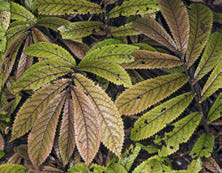 |
Elatostema rugosum. Photo: Jeremy Rolfe.
|
Eight of us spent three hours on the well-formed track advertised as taking 10-20 minutes. It starts in forest on a dry terrace, before descending to a boardwalk meandering through a wetland, which is open to the sky. The track then climbs to a lookout with tantalising views over the main lake. The track then traverses coastal forest with extensive nikau and kohekohe under tawa, pukatea and kahikatea. A second wetland, mostly dark and gloomy under a closed canopy, was relieved by a bright patch of
Elastostema rugosum near a stream.
We found a good age-range among the nikau, including seedlings with three or four short leaves, plants about to produce trunks, and mature specimens with many rings, and fronds 3 m or longer. Nikau rings aren’t produced annually, so age estimates weren’t possible, but John Dawson reports that nikau do not start to form trunks for 40-50 years. (Dawson and Lucas, 2011,
NZ’s Native Trees).
Back at the car park, we did a quick comparison of our three-hour ‘snapshot’ with Maggy Wassilieff’s and DJ Clark’s 1984 list. That’s 31 years ago. Graeme Jane’s list arrived by e-mail two days later. He used the multi-site spreadsheet system we’d used at St Arnaud to record the lists for 1984 and 2015 alphabetically, i.e. xx for both, x_ for 1984 only, and _x for 2015 only. Thanks Graeme. It worked well. Some of the results are shown in table 1.
We added many new adventives to the original list of 64 species, including
Bidens frondosa,
Cyperus eragrostis, a
Pseudopanax crassifolius /
P. lessonii hybrid, and the fern
Pteris cretica.
So, what does the comparison tell us about changes over the last 30 years? Possibly not much. More extensive searching would be necessary to establish which of the species we didn’t find are still present, which have gone, and what other species have arrived in the last 30 years. Is it worth compiling separate lists where visits are decades apart, instead of just recording additions? I think so. Some patterns may emerge, and it may inspire and provide a focus for future visits.
Table 1: Comparison of plants recorded during this field trip with Wassilieff & Clark 1984.
| Indigenous plants | Wassilieff & Clark 1984 | BotSoc April 2015 | Comment |
| Podocarps | 5 | 3 | We didn’t find totara or miro |
| Monocot trees | 2 | 2 | Nikau and cabbage tree both present |
| Dicot trees and shrubs | 61 | 33 | We found 2 species not on the 1984 list: Coriaria arborea, Myrsine australis. We didn’t see manuka, kanuka, swamp maire, 3 Coprosma, 3 Nestegis & some other species |
| Dicot lianes | 12 | 12 | We didn’t see Fuchsia perscandens or Rubus schmidelioides, but did find Clematis foetida and Calystegia tuguriorum |
| Ferns | 56 | 29 | Cyathea medullaris was a surprising addition, but C. cunninghamii and Dicksonia fibrosa eluded us. We saw none of the 3 Hypolepis species found in 1984, and only 2 of the 7 Hymenophyllum. |
DOC’s website notes that “The wetland forest associations of kahikatea / pukatea, tawa and pukatea-tawa-swamp maire are now rare.” Swamp maire (
Syzygium maire) was recorded in 1984, but we didn’t see it. DOC also mentions that
Korthalsella salicornioides, the rare leafless mistletoe, is found on manuka, so that is another species to look for.
Bev Abbott
5.4.15: Hokio Beach Dunes
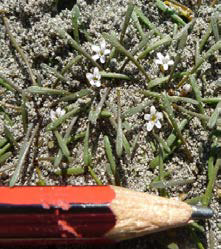 |
Limosella lineata.
|
After lunch, six of us drove from Papaitonga SR to Hokio’s coastal sand dunes. From the 1967 plant list, I had expected that there would be podocarp / tawa forest to the south of Hokio Stream. A long-term local explained that he had not seen such forest on this coastal strip, and would not expect to, as there was no clay soil, just sand. In the 1970s, pines were planted on the dunes. From the map it seems that any forest was c. 4 km south of Hokio. We did not propose to go so far.
We did walk c. 1 km south, along the track where the river once flowed into lagoons. It now flows directly to the sea, leaving a solid band of sedges, rushes and
Typha orientalis in the old river bed, and a weedy dune area on the inland side.
Exploring north along the beach side of the old river, there was one pleasant surprise. Gael found it and Graeme identified it – the minute
Limosella lineata that we had seen at Foxton Beach three years earlier, where Leon Perrie photographed it.
Wading up to our ankles to cross to the north side of Hokio Stream, Graeme finally discovered the
Pimelea villosa subsp.
arenaria that he had expected to find. This subspecies was reported by Colin Burrows¹ on the coast from Whanganui south, round to the east coast of the North Island, to about as far north there as it is on the west coast. At Hokio, it is growing on a dune bank with
Coprosma acerosa and
Ozothamnus leptophyllus.
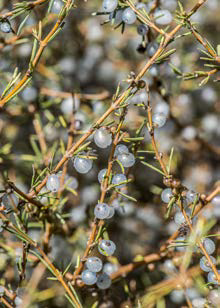 |
Coprosma acerosa. Photo: Jeremy Rolfe.
|
The 2015 plant list for Hokio Beach will be shorter than the “Hokio-Ohau River Mouth along the coast” list we started with.
Rodney Lewington
Participants: Bev Abbott, Sam Buckley, Gael Donaghy, Sheena & Stuart Hudson, Graeme Jane, Brenda Johnston, Rodney Lewington, Pat McLean, Chris Moore, Mick Parsons (leader), Leon Perrie, Lara Shepherd, Darea Sherratt.
¹. Burrows, C. J. 2009: Genus
Pimelea (Thymelaeaceae) in New Zealand 3. The taxonomic treatment of six endemic hairy-leaved species.
New Zealand journal of Botany 47: 325 –354.

 Site Index
Site Index







 Site Index
Site Index





